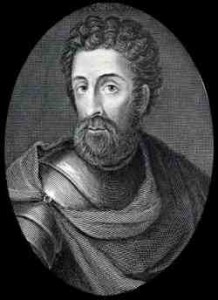
WILLIAM Wallace became a hero by “accident” a Scots academic has claimed.
Professor Dauvit Broun from Glasgow University said the iconic Scottish freedom fighter may not have been the sole leader during Scotland’s rise against the English.
The history expert said his research revealed the true story of Wallace’s defeat of William Heselrig, the Sheriff of Lanark.
Writing on the website Breaking of Britain, which is dedicated to Scottish history, Broun claimed there were “questions” raised over a “tangled web of double dealing and deceit” and claimed Wallace may have ended up as the figurehead for the uprisings by “accident”.
He also claims that the early part of the wars of independence was “as much down to” a knight by the name of Richard of Lundie as it was to Wallace.
He said: “Richard of Lundie was a close ally of William Wallace and rose with him in opposition to the English occupation of Scotland.
SLAYING OF SHERIFF
“It was Lundie who led the band with Wallace that was responsible for the killing of the Sheriff of Lanark on May 3, 1297.
“But just a few weeks after this, when it seemed as though the most prominent leaders of the rebellion, including the future king Robert the Bruce, James Stewart and the Bishop of Glasgow, would sue for peace, Lundie decided to go over to the English, presumably to save his own skin.”

At the Battle of Stirling Bridge, when Wallace and Sir Andrew Murray led the Scots to victory, Lundie fought for the English forces.
Professor Broun argues that the outcome of the battle, one of the most decisive of the Scottish Wars of Independence, could have been very different if the man in charge of the English army, the Earl of Surry, had taken advice offered by their new recruit.
According to a chronicle of the time, Lundie advised the English to send some soldiers over the River Forth to attack the Scots from behind.
However this option was dismissed as too costly and the Scottish force overwhelmed the English as they crossed the bridge, resulting in Wallace’s fame.
SWITCHED SIDES
But the academic claims there is another “intriguing” twist to the tale, as Lundie may have later switched sides again.

Professor Broun said:”Nothing is heard about Richard of Lundie after the Battle of Stirling Bridge, but an English song of the time blames their defeat on his treachery.
“Could it be that Richard of Lundie swapped sides again once he saw the way the battle was going?”
He added it is “not hard to imagine” how the knights name had disappeared from history, as when the “myth” of Wallace grew the Scots would have found it “hard to accept that a turncoat and renegade such as Richard of Lundie could have been responsible for the slaying of the Sheriff of Lanark that set in train the popular revolt against English rule”.
He continued: “This put’s Wallace’s leadership in a new light. It is known that he was a co-leader with William Douglas when the English justicar was attacked, and co-leader at Stirling Bridge with Andrew Murray.
“Now we can see he was no more than a co-leader at the iconic slaying of the Sheriff of Lanark too.
“Wallace became the legendary leader of Scottish resistance by accident, by the death, capture or surrender of their colleagues.”
